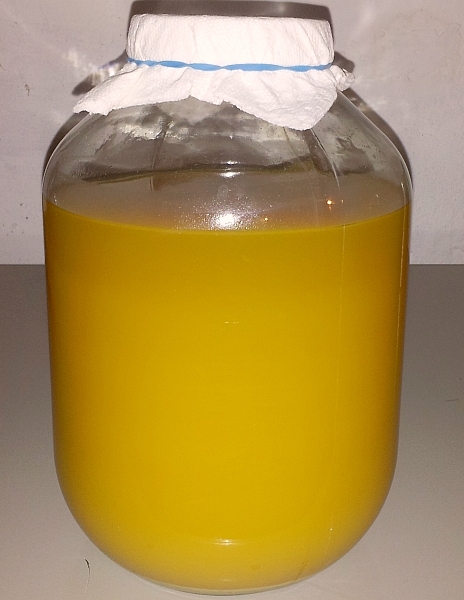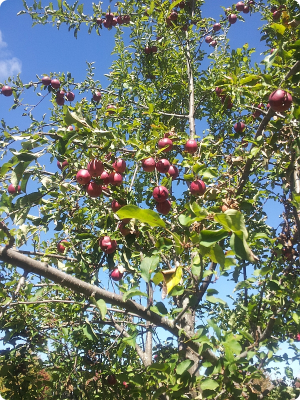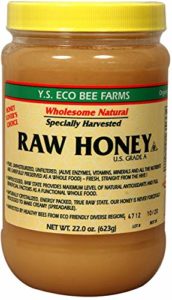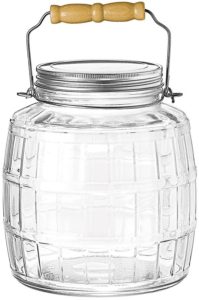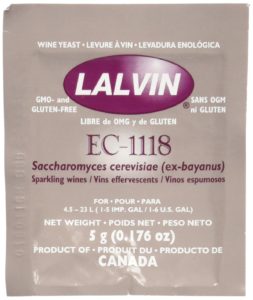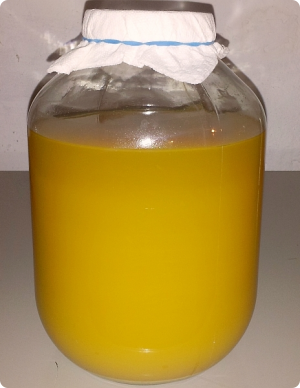 There are a lot of reasons to make your apple cider vinegar. Maybe there is no ACV where you live, maybe it is too expensive, or maybe you want to have complete control of the ingredients. Whatever the reason, making apple cider vinegar in not complicated and is fun, at least it is for me.
There are a lot of reasons to make your apple cider vinegar. Maybe there is no ACV where you live, maybe it is too expensive, or maybe you want to have complete control of the ingredients. Whatever the reason, making apple cider vinegar in not complicated and is fun, at least it is for me.
Apple cider vinegar is great addition to many salads, and it is a great dietary supplement, used for treating naturally many ailments and conditions. Making your own ACV allows you decide on the density, clarity and the strength of the vinegar.
Vinegar is a prebiotic, and if you make yours from apples, you combine the prebiotic effects with the nutritional value of ACV. For more information about apple cider vinegar, read my article about health benefits of ACV.
Why Another ACV Recipe?
This recipe, as simple as it is, is perfected to retain maximum nutrients from the apples, and is a soft vinegar, without too much acidity, to keep it palatable. Also, if you make it with honey, you will get additional benefits. Sugar works fine, but honey has a lot of enzymes, and is a great antibacterial, and the ACV is traditionally fermented with honey, for the added benefits.
Ingredients
- 2 lb Apples
- 3 ounces raw unpasteurized honey (or sugar)
- 33 ounces water
- wine yeast
Instructions
- You can buy the apples at the food store, or pick them yourself if possible. I picked them from a tree that grows wild in the neighborhood. The apples are not very sweet so I needed to add some honey, but if you buy desert apples, they are sweet enough and shouldn’t need additional sweetener. The sweetener is needed for the vinegar’s strength, if you there is not enough sugar in your apples, the cider will not make enough alcohol, and the vinegar will be too week.
- The wine yeast is used to speed up the fermentation but is not absolutely necessary. Do not use bread yeast, as it is not the yeast that will ferment properly. The bacteria in the bread yeast are not the same as in the wine yeast. Generally, I prefer the wild fermentation, because there is a wider bacterial spectrum than in a controlled fermentation. But for vinegar you only need to transform the sugar into acetic acid, and the bacteria will be dead anyway at the end.
- You can cut the apples in four quarters. But if you crush them or puree them using a blender, the full fermentation will be completed faster. On the other hand, you will get a cloudier vinegar at the end. I like it better that way.
 Y.S. Eco Bee Farms Raw Honey – 22 oz
Y.S. Eco Bee Farms Raw Honey – 22 oz
This is pure raw, unheated, unpasteurized honey, the way it should be in order to preserve its curative properties. Raw honey is the way we should eat it, because besides the sugar and the trace minerals, it contains some other amazing compounds and enzymes, that are unique.
The honey from Y.S. Eco Bee Farms is organic, which means no chemicals are used on the field that the bees fly, and no chemicals are used for maintaining the beehives. The bees are specifically isolated in areas where they cannot fly in contaminated areas, such as agricultural areas, or golf courses.
Detailed Instructions for Making Apple Cider Vinegar
Make Apple Cider Vinegar from Scratch

Puree the apples in a blender adding a little water to each batch. Dissolve the honey in a little warm water, making sure you don’t heat the water too much. Too much heat will pasteurize your honey turning it into an expensive sugar. Put the apple puree, the honey, and the wine yeast in a recipient, such as a big glass jar, or a plastic bucket. Do not use a metal recipient.
 Anchor Hocking 1-Gallon Glass Barrel Jar with Lid
Anchor Hocking 1-Gallon Glass Barrel Jar with Lid
This is a 1 gallon glass jar, with a handle and lid. This is perfect for small scale production, because it’s easier to handle and to store. If you make more than 3 gallons at a time, I recommend look into larger barrels, as you will manage space better with thoso/
The jar is perfect for making vinegar, and the price is decent. Don’t expect the lid to be airtight though, because it isn’t, and the handle is not meant to be used when the jar is full. It can only be used when is empty.
Place the recipient in a dark place, at a temperature around 84 degrees Fahrenheit; this is the optimum temperature for the best fermentation of your apples. Mix the apples every day for about 10 days or until the apple puree starts to sink at the bottom.
If you are not using yeast, this could be a lot longer. It could take up to 60 days, depending on the temperature. I personally love wild fermentation, because it gives the apple cider vinegar a different, milder taste. And if you use honey in your recipe, and not sugar, you control the strains that can grow. This leaves lower chances for spoilage.
However, using a yeast as the starter has its own advantages, such as spoilage prevention,
 Lalvin Dried Wine Yeast EC #1118
Lalvin Dried Wine Yeast EC #1118
If you want to speed up the fermentation of any fruit based fermented drink, you need yeast. The wine yeast is the one that is recommended for ACV. Do not try to substitute with other types of yeast, you will obtain a different vinegar, with a specific taste. Lalvin Dried Wine Yeast is a great option.
EC-1118 contains Saccharomyces cerevisiae, it used to be named Saccharomyces bayanus, and is one of the most used yeasts for wine fermentation. It has a wide temperature range, which means you don’t have to be very strict with the environment temperature. Be carefull, that it is very resistent to alcohol, so your drink or vinegar can end up very strong, if you add too much sugar.
After the apples start to sink, strain using a cheese cloth, and pour into big glass jars. Strain as much liquid as you can and do not worry if it is very cloudy, for now. Leave the apple cider in the jars for further fermentation for another 40-60 days, or even longer, until all the alcohol turns into acetic acid.
Once this is completed, transfer the apple cider vinegar into wine bottles. Screw caps are the best for short term storage; however, if you intend to store the vinegar for a long time, corks are the best. Place the bottles inclined at 30 degree angle, with the neck down. This will help to seal the bottle, preventing air to get in, hence stopping the fermentation.
